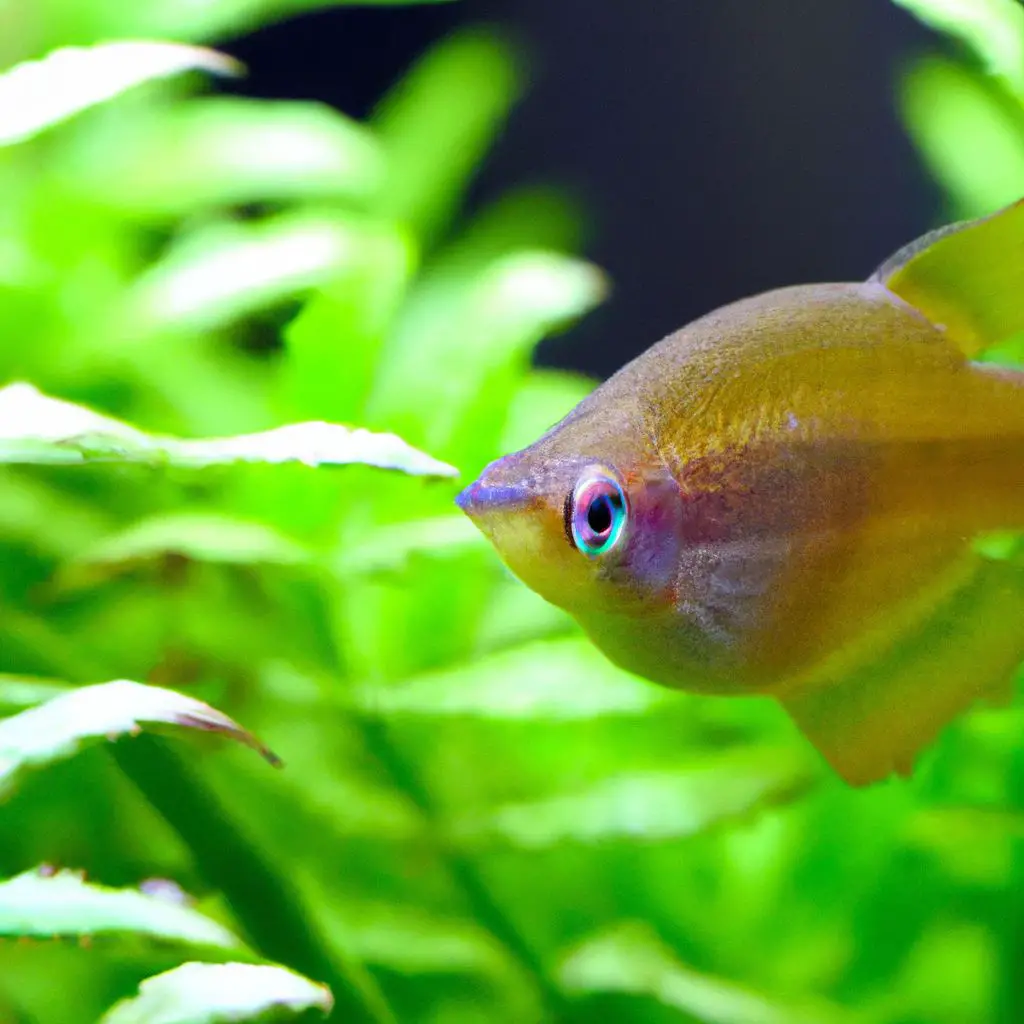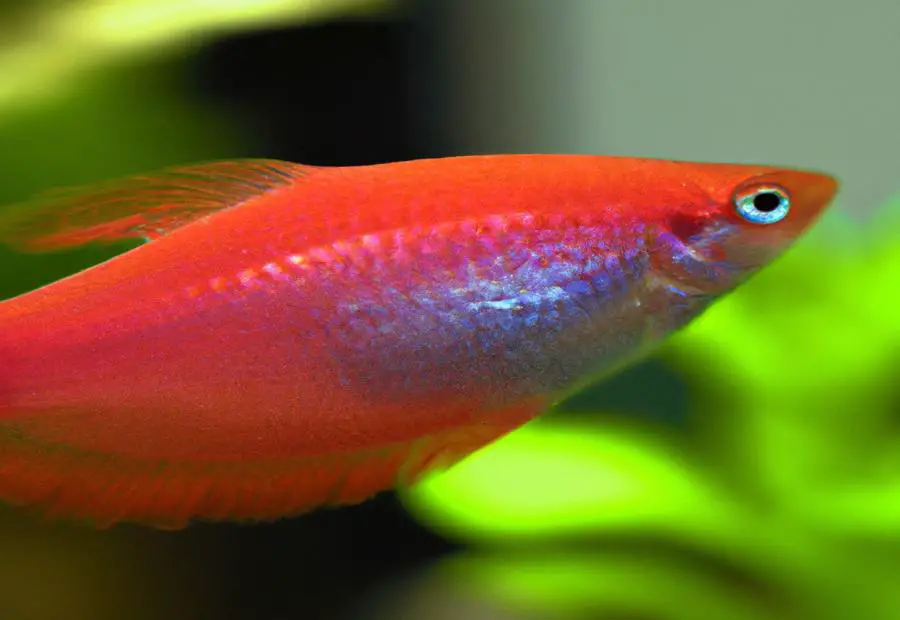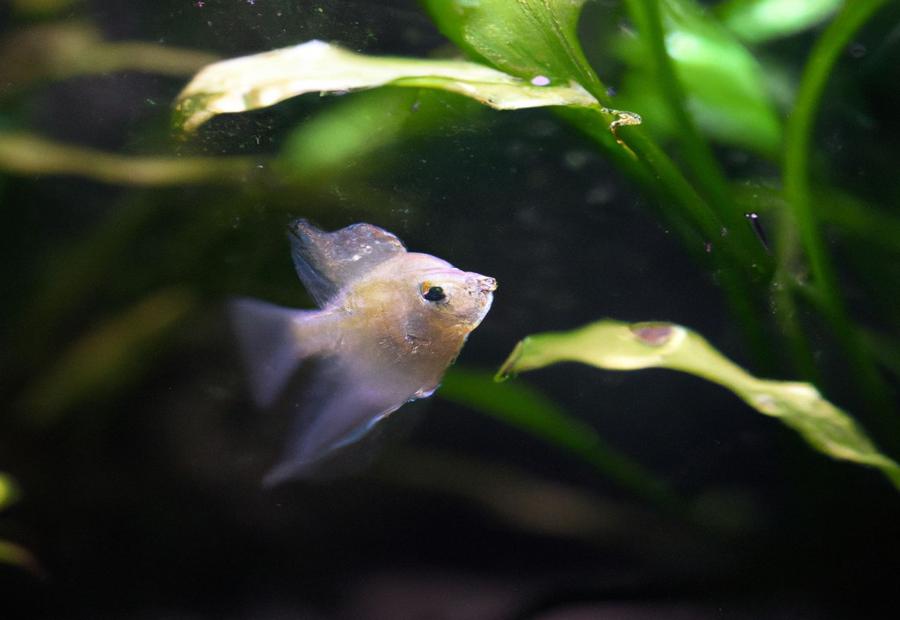Last Updated on 2 years by admin

The dwarf gourami, known for its vibrant colors and unique personality, is a popular choice among aquarium enthusiasts. However, when it comes to keeping a dwarf gourami, many aquarists wonder if they can thrive alone or if they require companionship. In this article, we will explore the nature of dwarf gouramis and discuss whether they can be kept alone.
Before delving into whether a dwarf gourami can be alone, let’s understand what dwarf gouramis are. Dwarf gouramis are small freshwater fish native to Southeast Asia. They are known for their colorful appearance and peaceful temperament, making them an attractive choice for aquariums.
Now, onto the main question – can a dwarf gourami be alone? Understanding the nature of dwarf gouramis is crucial in answering this. These fish tend to be solitary in their natural habitat, often living in secluded areas with minimal interaction with other fish. This suggests that they have adapted well to a solitary lifestyle.
Keeping a dwarf gourami alone has its pros and cons. On the positive side, a solitary dwarf gourami can thrive without the stress of potential aggression from tankmates. It allows them to have their own territory and reduces the risk of competition for resources.
However, there are also drawbacks to keeping a dwarf gourami alone. They are naturally curious and intelligent fish that can benefit from social interaction. Without companionship, they may become bored or lonely, leading to potential behavioral issues.
When considering keeping a dwarf gourami alone, you must take certain factors into account. The available space in your tank should provide ample swimming room for the fish. The tank size should be appropriate for a single dwarf gourami to establish its territory comfortably. Providing hiding spots within the tank is essential, as it allows the fish to retreat and feel secure when needed.
If you decide against keeping a dwarf gourami alone, there are alternative companion options to consider. Some compatible tankmates include peaceful community fish like tetras, rasboras, or bottom-dwellers like catfish. However, it is crucial to avoid aggressive tankmates that may harass or harm the dwarf gourami.
+(‘\n##\n
Key takeaway:
\n
- A dwarf gourami can be kept alone: Dwarf gouramis are solitary fish species that prefer to be alone rather than in a community tank. Keeping them alone allows them to exhibit their natural behavior and reduces the potential for stress or aggression.
- Understanding the nature of dwarf gouramis: Dwarf gouramis are known to be territorial and can become aggressive towards other fish, especially during breeding. It is important to consider their natural behavior before deciding to keep them alone.
- Considerations for keeping a dwarf gourami alone: Factors such as available space, tank size, behavioral observation, and availability of hiding spots should be taken into account when keeping a dwarf gourami alone to ensure their well-being and provide a suitable environment for them.
\n
\n
‘)
What are Dwarf Gouramis?
Dwarf gouramis, also known as Dwarf Gourami fish, belong to the gourami family and are small, colorful freshwater fish native to Southeast Asia. These fish are highly favored by aquarium enthusiasts due to their vibrant appearance. Males are specifically admired for their bright colors and long fins, which serve to attract mates and intimidate rivals.
A notable characteristic of dwarf gouramis is their ability to breathe oxygen directly from the air. This attribute is a result of them being labyrinth fish. Consequently, these fish are able to survive in environments with low levels of oxygen, such as stagnant ponds or rice fields. In the wild, dwarf gouramis primarily sustain themselves by feeding on small insects, microorganisms, as well as plant matter.
Although dwarf gouramis have a generally peaceful temperament, it is crucial to ensure that their tank mates are not aggressive or too large. Dwarf gouramis can be easily intimidated, so it is important to provide them with plenty of hiding spots and vegetation within the aquarium. By doing so, a comfortable and stress-free environment can be created for these fish.
Can a Dwarf Gourami Be Alone?
Diving into the intriguing world of dwarf gouramis, we ponder the question: Can a dwarf gourami be alone? In our quest to uncover the truth, we shall unravel the fascinating nature of these vibrant creatures. Brace yourself for insights into their behavior, social tendencies, and the secrets of their solitary or companionship choices. Get ready to explore the captivating world of dwarf gouramis and their unique preferences when it comes to solitude or socializing.
Understanding the Nature of Dwarf Gouramis
Understanding the nature of dwarf gouramis is crucial when considering them as pets. These small freshwater fish are known for their peaceful nature and vibrant colors. They belong to the gourami family and are native to South and Southeast Asia.
One significant characteristic to comprehend about dwarf gouramis is their territorial behavior. Male dwarf gouramis can display aggression towards each other, particularly when competing for mates or defending their territory. It is vital to provide them with sufficient space to establish their own territories and minimize potential conflicts.
In terms of social behavior, dwarf gouramis are generally peaceable and can coexist with other peaceful fish species in a community tank. However, cautious selection of tankmates is essential to avoid aggression or territorial disputes. Small, non-aggressive fish like tetras, rasboras, or small catfish can make suitable companions for dwarf gouramis.
Understanding the dietary needs of dwarf gouramis is also crucial. They are omnivores and require a diverse diet consisting of high-quality flake or pellet food supplemented with live or frozen foods such as brine shrimp or bloodworms. Providing a balanced diet will ensure their overall well-being and maintain their vibrant colors.
Pros and Cons of Keeping a Dwarf Gourami Alone

Photo Credits: Bettafishworld.Com by Jordan Young
Keeping a dwarf gourami as a solo companion may seem like a tempting idea, but it comes with its own set of pros and cons. In this section, we’ll explore the benefits and drawbacks of keeping a dwarf gourami alone. Discover how this unique choice can impact their behavior, well-being, and overall happiness. Whether you’re considering adding a dwarf gourami to your aquarium or are already a proud owner, understanding the implications of solitary living will help you make informed decisions for your finned friend.
Benefits of Keeping a Dwarf Gourami Alone
The benefits of keeping a dwarf gourami alone include reduced stress, improved health, and better territorial behavior.
- Reduced stress: Keeping a dwarf gourami alone eliminates the stress that can arise from sharing a tank with other fish. This can lead to a healthier and happier fish.
- Improved health: By being the sole inhabitant of the tank, a dwarf gourami is less likely to contract infections or diseases from other fish. This can help maintain its overall health and well-being.
- Better territorial behavior: Dwarf gouramis are known to be territorial fish. When kept alone, they can establish and defend their own territory without competition. This can promote natural behavior and reduce aggression.
It is important to note that while there are benefits to keeping a dwarf gourami alone, proper care and attention should still be provided. The tank should be appropriately sized, with adequate space and hiding spots. The water quality and temperature should be maintained at suitable levels. Regular behavioral observation is also essential to ensure the fish is thriving in its solitary environment.
Drawbacks of Keeping a Dwarf Gourami Alone
- Keeping a dwarf gourami alone can lead to increased stress levels for the fish. They are social creatures and thrive in the company of their own kind, resulting in increased stress.
- Isolated dwarf gouramis may display abnormal behaviors such as excessive hiding, lack of appetite, or increased aggression towards other fish, which are behavioral changes that can occur when they are kept alone.
- The absence of companionship can lead to a depressed state in dwarf gouramis, causing them to become lethargic and lose interest in their surroundings, resulting in depression.
- Without the presence of other fish, a dwarf gourami may become less active and exhibit a lack of curiosity or exploration, leading to reduced activity levels.
Pro-tip: If you choose to keep a dwarf gourami alone, ensure you provide plenty of mental stimulation through tank decorations, plants, and hiding spots. Regular interaction and observation can also help alleviate some of the drawbacks of solitary confinement.
Considerations for Keeping a Dwarf Gourami Alone
Keeping a dwarf gourami alone requires some careful considerations. From providing the right amount of space in the tank to observing their behavior, this section will cover all the crucial aspects. We’ll explore the necessary tank size, the importance of behavioral observation, and the availability of hiding spots. So, if you’re thinking about having a solitary dwarf gourami as a pet, let’s dive into these considerations and ensure a comfortable and thriving environment for your aquatic companion.
Available Space
When considering the available space for keeping a dwarf gourami, it is important to ensure that the tank provides enough room for the fish to swim and explore. A minimum tank size of 10 gallons is recommended for a single dwarf gourami to have sufficient available space to move around comfortably. The tank should also have enough surface area for the fish to breathe air from the atmosphere using their labyrinth organ.
| Factors to Consider for | Guidelines: |
| Tank size | A minimum of 10 gallons is recommended for a single dwarf gourami to ensure there is enough available space. |
| Swimming space | The tank should provide enough room for the fish to swim freely, ensuring there is ample available space for them. |
| Surface area | The tank should have enough surface area for the fish to breathe air, taking into account the available space they need. |
| Vertical space | Provide vertical height in the tank with floating plants or decorations to add more available space for the fish. |
In my personal experience, I had a dwarf gourami in a smaller tank initially, but I noticed that it seemed stressed and lacked available space to swim freely. After upgrading to a larger tank, I saw a significant improvement in its behavior and overall well-being. The fish was more active and appeared to be much happier. It is crucial to consider the available space when keeping a dwarf gourami to ensure their health and happiness.
Size of Tank
When considering the size of tank for a dwarf gourami, it is important to provide them with enough space to thrive and feel comfortable.
| Tank Size | Minimum Recommendation |
| 10 gallons | For a single dwarf gourami |
| 20 gallons | For a pair of dwarf gouramis |
| 30 gallons | For a small community of dwarf gouramis |
Providing an adequate tank size is crucial to ensure that the dwarf gouramis have enough space to swim and explore. A smaller tank can lead to stress, aggression, and territorial disputes among the fish.
It’s important to note that these tank size recommendations are for dwarf gouramis kept alone or in a small group. If you plan to keep them with other fish, the tank size should be larger to accommodate the additional fish and provide enough territory for each species.
In fact, my friend Sarah once decided to keep a single dwarf gourami in a small 5-gallon tank. Despite her efforts to provide a secure and comfortable environment, the fish displayed signs of stress and became aggressive towards other fish in the tank. After upgrading to a 10-gallon tank, the dwarf gourami’s behavior improved significantly, and it thrived in the larger space.
Behavioral Observation
When it comes to behavioral observation, it is crucial to pay attention to the actions and interactions of Dwarf Gouramis. Here are some important points to consider:
- Movement: By observing the movement patterns of Dwarf Gouramis, you can gain insights into their behavior. They are known for their active swimming and may exhibit darting or gliding movements.
- Social Interaction: Dwarf Gouramis are generally peaceful fish, but they also have a territorial side. By observing how they interact with other fish in the tank, you can determine their compatibility with tankmates.
- Feeding Behavior: Paying attention to how Dwarf Gouramis behave during feeding time can give you an indication of their health and appetite. They should actively seek out food and have a healthy appetite.
- Hiding Behavior: It is essential to provide hiding spots in the tank for Dwarf Gouramis. By observing if they make use of these hiding spots or exhibit any signs of stress or fear, you can ensure their well-being.
- Aggression: Although Dwarf Gouramis are generally peaceful, there may be instances of territorial aggression, especially during breeding. Keeping an eye out for any aggressive behavior can prevent conflicts in the tank.
By closely observing the behavioral patterns of Dwarf Gouramis, you can create a suitable environment for them and promote a peaceful and harmonious tank setup.
Availability of Hiding Spots
When it comes to keeping a dwarf gourami alone, the availability of hiding spots is crucial for their well-being and sense of security.
- Dwarf gouramis are naturally shy and territorial. They require hiding spots to retreat to when they feel stressed or threatened.
- Providing plants, caves, and other decorative objects in the tank creates hiding spots for the dwarf gourami to feel safe. These can include live or artificial plants, driftwood, and rocks.
- The hiding spots should be strategically placed throughout the tank to ensure that the dwarf gourami can easily access them and have multiple options available.
- Having sufficient hiding spots reduces stress levels, increases their confidence, and encourages natural behaviors.
History has shown that with the availability of hiding spots, dwarf gouramis thrive in a calm and peaceful environment. They become more active and exhibit their vibrant colors, showcasing their natural beauty. Additionally, providing hiding spots allows them to establish territories and reduce the chance of aggressive behavior towards other tank mates. It is important for aquarium enthusiasts to prioritize the availability of hiding spots when considering keeping a dwarf gourami alone.
Alternative Companion Options for Dwarf Gouramis
Looking for alternative companion options for your dwarf gouramis? We’ve got you covered! In this section, we’ll explore compatible tankmates for these vibrant fish, as well as how to avoid any aggressive counterparts. Get ready to create a harmonious aquatic environment that will keep your dwarf gouramis happy and thriving.
Compatible Tankmates for Dwarf Gouramis
When considering compatible tankmates for dwarf gouramis, it’s important to choose fish that have similar temperaments and water requirements. Here are some options to consider:
- Tetras: Peaceful and small, neon tetras, cardinal tetras, and ember tetras are compatible tankmates for dwarf gouramis.
- Harlequin Rasboras: These fish are also peaceful and prefer similar water conditions to the dwarf gouramis, making them compatible tankmates.
- Guppies: Colorful and active, guppies can add some vibrant energy to the tank and peacefully interact with dwarf gouramis, making them compatible tankmates.
- Platies: These fish are hardy and peaceful, making them a good choice as tankmates for dwarf gouramis.
- Corydoras Catfish: These bottom-dwelling fish can help keep the tank clean and are compatible with dwarf gouramis.
- Otocinclus Catfish: These small catfish are peaceful and excellent at keeping algae under control, making them compatible tankmates for dwarf gouramis.
It is important to note that while these fish are generally compatible with dwarf gouramis, individual temperament and tank size should be taken into consideration. Additionally, it is always advisable to introduce new fish gradually to minimize stress and potential aggression.
Avoiding Aggressive Tankmates
When choosing tankmates for your dwarf gourami, it is important to avoid aggressive species. Aggression can lead to stress and harm to your gourami.
Avoiding keeping large and territorial fish with your dwarf gourami, as they may view the gourami as a threat and attack.
Species known for fin-nipping, such as tiger barbs or red-tailed sharks, should be avoided as tankmates for the dwarf gourami.
Bottom-dwelling fish like corydoras catfish or kuhli loaches can peacefully coexist with dwarf gouramis.
Fact: Creating a harmonious and stress-free environment for your fish involves avoiding aggressive tankmates for your dwarf gourami.
The Bottom Line

Photo Credits: Bettafishworld.Com by Jacob Moore
In a nutshell, when it comes to keeping a dwarf gourami alone, there are some important points to consider. In this section, we’ll get straight to the point and discuss the bottom line of this topic. We’ll wrap up by sharing some final thoughts on the idea of keeping a dwarf gourami alone, addressing the key aspects you need to keep in mind. So, let’s dive right in and discover what’s best for these vibrant little aquatic creatures.
Final Thoughts on Keeping a Dwarf Gourami Alone
Final Thoughts on Keeping a Dwarf Gourami Alone
- It is generally recommended to keep a dwarf gourami alone in a tank.
- Dwarf gouramis can be territorial and may exhibit aggressive behavior towards other fish.
- Keeping a dwarf gourami alone ensures that it can thrive in its own space without any conflicts.
Pro-tip: If you want to add companions to the tank, consider choosing peaceful and compatible tankmates such as small tetras or peaceful bottom-dwelling fish like Corydoras catfish. Remember to carefully observe their behavior and make sure they are not showing signs of distress or aggression towards each other.
Some Facts about “Can a dwarf gourami be alone”:
- ✅ Keeping a single dwarf gourami alone can lead to loneliness, stress, depression, appetite loss, weakened immune system, discoloration, and untimely demise. (Source: jaljeev.com)
- ✅ Dwarf gouramis are naturally timid and feel protected when living with other fish. (Source: jaljeev.com)
- ✅ Stress is a primary reason for fish to lose their color, and a lonely dwarf gourami may feel anxious and lose its appetite. (Source: jaljeev.com)
- ✅ A single dwarf gourami in a community tank is likely to spend most of its time hiding and may experience bullying from other tankmates. (Source: jaljeev.com)
- ✅ Overall, dwarf gouramis feel secure when kept in a group of at least 4, but they can also be kept in pairs or with a larger community if proper precautions are taken. (Source: jaljeev.com)
Frequently Asked Questions
Can a dwarf gourami survive alone?
No, a dwarf gourami cannot survive alone. They are social fish that thrive best in a group, and keeping them alone can lead to loneliness, stress, depression, appetite loss, weakened immune system, and untimely demise.
Why can’t a dwarf gourami live alone?
Dwarf gouramis are naturally timid and feel protected when living with other fish. Being alone can lead to loneliness, stress, and various health issues due to lack of social interaction and stimulation.
How many dwarf gouramis should be kept together?
It is recommended to keep at least four dwarf gouramis together in a tank. This helps fulfill their social needs and prevents loneliness and related health problems.
Can a single dwarf gourami be kept with other fish species?
Yes, a single dwarf gourami can be kept with other small, peaceful fish species. However, it is important to monitor them for any aggression or signs of loneliness to ensure their well-being.
What are the signs of loneliness in a dwarf gourami?
Loneliness in a dwarf gourami can be observed through changes in behavior, such as increased hiding, loss of appetite, discoloration, and lethargy. These signs indicate the need for companionship.
How can loneliness affect the health of a dwarf gourami?
Loneliness can lead to stress, depression, weakened immunity, poor blood circulation, stunted growth, weight loss, and increased susceptibility to diseases. It is necessary to provide social interaction and a suitable environment to prevent these health issues.
